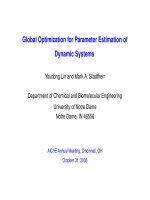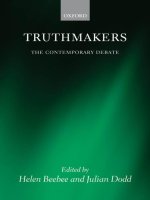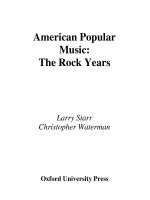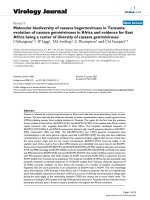- Trang chủ >>
- Khoa Học Tự Nhiên >>
- Vật lý
ancient israel in sinai the evidence for the authenticity of the wilderness tradition oct 2005
Bạn đang xem bản rút gọn của tài liệu. Xem và tải ngay bản đầy đủ của tài liệu tại đây (2.39 MB, 360 trang )
Ancient Israel in Sinai:
The Evidence for the
Authenticity of the
Wilderness Tradition
JAMES K. HOFFMEIER
OXFORD UNIVERSITY PRESS
Ancient Israel in Sinai
This page intentionally left blank
Ancient Israel
in Sinai
The Evidence for the Authenticity
of the Wilderness Tradition
james k. hoffmeier
1
2005
3
Oxford University Press, Inc., publishes works that further
Oxford University’s objective of excellence
in research, scholarship, and education.
Oxford New York
Auckland Cape Town Dar es Salaam Hong Kong Karachi
Kuala Lumpur Madrid Melbourne Mexico City Nairobi
New Delhi Shanghai Taipei Toronto
With offices in
Argentina Austria Brazil Chile Czech Republic France Greece
Guatemala Hungary Italy Japan Poland Portugal Singapore
South Korea Switzerland Thailand Turkey Ukraine Vietnam
Copyright # 2005 by Oxford University Press, Inc.
Published by Oxford University Press, Inc.
198 Madison Avenue, New York, New York 10016
www.oup.com
Oxford is a registered trademark of Oxford University Press
All rights reserved. No part of this publication may be reproduced,
stored in a retrieval system, or transmitte d, in any form or by any means,
electronic, mechanical, photocopying, recording, or otherwise,
without the prior permission of Oxford University Press.
Library of Congress Cataloging-in-Publication Data
Hoffmeier, James Karl, 1951–
Ancient Israel in Sinai : the evidence for the authenticity of the
wilderness tradition / James K. Hoffmeier.
p. cm.
Includes bibliographical references and index.
ISBN-13 978-0-19-515546-4
ISBN 0-19-515546-7
1. Bible. O.T. Exodus XVI–Numbers XX—Criticism, interpretation, etc.
2. Bible. O.T. Exodus XVI–Numbers XX—Evidences, authority, etc. 3. Bible. O.T.
Exodus XVI–Numbers XX—History of biblical events. 4. Bible. O.T. Exodus XVI–
Numbers XX—Geography. 5. Sinai (Egypt)—Antiquities. I. Title.
BS1245.52.H64 2005
222'.12095—dc22 2004021554
987654321
Printed in the United States of America
on acid-free paper
Dedicated to Alan Millard
on the occasion of his retirement from
the University of Liverpool
in appreciation of many years of
friendship and encouragement
This page intentionally left blank
Foreword
Here, in the early twenty-first century, we are heirs to two centuries
of breathtaking discoveries and to frontiers of knowledge push ed
out to vastly broadened horizons. In the pioneering nineteenth cen-
tury, the first broad outlines for our knowledge of the real biblical
world—the Ancient Near East—began to emerge with the decipher-
ment of Egyptian hieroglyphs and of the intricate Mesopotamian
cuneiform script. In the meantime, pioneer archaeologists probed the
secrets of ‘‘hundred-gated Thebes,’’ resurrected the vast palaces of
Nineveh and Babylon, probed deep into fabled Troy and Mycenae,
and opened up the geograp hy and mounds of Syria-Palestine, from
Palmyra to Petra.
In the tumultuous twentieth century, the rate of discovery
grew apace: first, with spectacular finds such as the golden treasures
of Tutankhamun in Egypt and of the royal tombs in ‘‘Ur of the
Chaldees’’; the wonders of Ugarit, Mari, and Ebla in Syria; or the
Dead Sea Scrolls in Palestine; and second, with a growing refinement
and precision, especially in field archaeology and the introduction
of useful techniques from the natural sciences in the last fifty years.
And today, both the growth and the refining of knowledge and
how we understand it continue to expand.
It is in this wider panoramic context that we may set Professor
James K. Hoffmeier’s new book on Egypt, Sinai, and earliest Israel.
He has already spent most of an active lifetime in the professional
study of ancient Egypt and of the Hebrew Bible in its ancient context.
Egypt’s East Delta and North Sinai districts have always been zones
of continual contact and transi t between Egypt and her northeast
neighbors, from prehistory to the present. But effective, modern-quality ar-
chaeological work in these particular districts is of recent date. Professor
Hoffmeier’s excavations and discoveries at Tell el-Borg have revealed remains
of an important Egyptian military staging post from the delta into northeast
Sinai on the route to Canaan, and this work has as a context the parallel work
done at ancient Avaris and Pi-Ramesse by Professors Manfred Bietak and
Edgar Pusch, and at Tell Hebua by Dr. Abd-el-Maksoud. Such is the back-
ground to James K. Hoffmeier’s new book, which sets the narratives of the
biblical exodus and wilderness travels of the early Hebrews in a fresh, up-to-
date, factua l context of the latest knowledge about the geography, routes, and
physical conditions in Delta and Sinai alike. The book also brings together the
results of wider study of the giving of law and covenant in Sinai, of the results
of modern study of the ancient use of portable structures (‘‘tabernacles’’) for
worship and cult, and of the occurrence of Egyptianizing proper names
among the Hebrews departing from Egypt, and it offers a calm, judicious
review of the ‘‘hot potato’’ subject of ancient Israel’s endlessly discussed
possible origins. And more besides! Thus, alongside his Israel in Egypt, Pro-
fessor Hoffmeier’s informative new volume on Egypt and Sinai in biblical
antiquity deserves likewise to serve a very wide readership.
—kenneth a. kitchen
viii foreword
Preface
The exodus from Egypt and the wilderness narratives that follow in
the Torah or Pentateuch contain the Bible’s version of how Israel
originated as a nation in Egypt, marched to Mt. Sinai where it entered
into a covenant relationship with God, and received the law before
entering the ‘‘Promised Land.’’ In recent years, the Egypt and Sinai
pillars of ancient Israel’s history have been shaken by questions raised
by som e critical scholars and by outright rejection from others. In
1997 in my book Israel in Egypt: The Evidence for the Authenticity of
the Exodus Tradition (Oxford), I argued—largely on the basis of
Egyptian background evidence—that there were good reasons to be-
lieve that the reports of the Hebrew sojourn and forced labor were
plausible. Considerable time was given to discussing the geographical
details of the exodus from Egypt and proposing a route taken by the
Hebrews to leave Egypt. Because of the importance of the wilderness
tradition to Israel’s origin and the current debate about this matter
over the past two decades, a similar study of the episodes in Sinai is
necessary. In a sense, this book is a logical sequel.
An examination of the wilderness tradition, which includes
Exodus 16 through Numbers 20, and a study of how later biblical
writers reflect on the wilderness episodes is offered in chapter 1,
followed by an examination of how historians of religion view
these episodes (chapter 2). I n this same chapter it is argued that in
view of the impasse between the scientific (modern) hermeneutic and
the postmodern approach to the wilderness tradition, a different
method is required. The phenomenological approach is offered as a
way out.
The setting of the wilderness tradition, the Sinai Peninsula, is one of the
most intriguing geographical regions in the world. Understanding the terrain
and climate enable readers of the wilderness tradition to comprehend better
the context of many of the episodes. Hence, an introduction to the geography
and ecological zones of Sinai is offered in chapter 3.
In the years since 1997, a number of important developments have oc-
curred that demand that some of the geographical discussions in Israel in
Egypt be reassessed. First, there continues to be a steady stream of studies that
question the historical reliability of most portions of the Torah, including the
wilderness tradition and geography of the exodus. Some of these include
Thomas Thompson’s The Mythic Past: Biblical Archaeology and the Myth of
Israel (1999), Israel Finkelstein and Neil Silberman’s The Bible Unearthed:
Archaeology’s New Vision of Ancient Israel and the Origin of its Sacred Texts
(2001), and an essay by John Van Seters, ‘‘The Geography of the Exodus’’
(2001). The conclusions of these works, and others like them, need to be
questioned in the light of new data from our investigations in Sinai.
Second, since the mid-1990s, new archaeological data from North Sinai
are available. I was inclined to identify Tell Hebua with Egypt’s ancient
frontier town of Tjaru/Sile in Israel in Egypt, but thanks to a new inscription
discovered in 1999, this identification has been confirmed. This new in-
formation means that one can be much more certain about the sequence of
Egyptian forts in North Sinai, if more were to be discovered. And this, in turn,
will play a significant role in identifying the location of the Egyptian fort
Migdol (the second fort east of Hebua), which is believed to be the same as the
Migdol of Exodus 14:2. This same verse indicates that Migdol is near the sea
crossed by Moses and the Israelites. Consequently, if we are able to locate the
approximate area of Migdol, then the location of the Re(e)d Sea can be pro-
posed with greater certainty.
After several years of archaeological surveying in North Sinai (1994–
1998), the East Frontier Archaeological Project, which I direct, began ex-
cavations at Tell el-Borg in 2000. After four seasons, we have discovered a
New Kingdom fort, clearly one of those named in Egyptian texts. This dis-
covery, along with the paleoenvironmental fieldwork by the project’s geologist,
Dr. Stephen O. Moshier, has made it possible to trace the route of the military
road from Egypt’s frontier and on toward Canaan. Chapter 4 will introduce
the new data and their implications for the geography of the exodus and travels
in Sinai. In my earlier book, I suggested several possible locations for the
Re(e)d Sea. Thanks to new evidence, and a more critical reading of texts such
as Exodus 14:2, a specific body of water can now be posited in chapter 5.
The location of Mt. Sinai, a problem that has bedeviled explorers, biblical
scholars, and archaeologists for centuries, is treated in chapter 6. Although no
earthshaking identification is made, careful analysis of the biblical texts does
allow us to eliminate a number of the propose d sites for the mountain where
x preface
Moses is said to have received the law. Also, the Torah does provide some
information that, I will argue, narrows down the general region where
Mt. Sinai was located.
How could the Israelites have traveled and lived in Sinai? Were there mil-
lions involved? Why is there no direct archaeological evidence for the Israelites in
Sinai? Does the wilderness itinerary of Exodus and Numbers make sense? These
probing questions are addressed in chapter 7.
Without a doubt, receiving the law at Mt. Sinai through Moses as inter-
mediary is one of the most memorable episodes of the Bible. Before dis-
cussing the law itself and how it is structured, it seems prudent to ask if
Moses (assuming he actually lived in the second half of the second millen-
nium b.c.) could have written; was there an alphabetic script like the Hebrew
known in the twelfth century b.c. available for use a century or two earlier?
Chapter 8 discusses this matter, followed by studying the literary form of the
Sinai covenant in a comparative way with surviving ancient Near Eastern
treaties.
The origins of Israel’s cultic worship, according to the Torah, is closely
tied to the law given at Sinai, and hence a sanctuary was required. What better
option for a people in a wilderness and without a permanent home and wor-
ship center than to possess a tentlike sanctuary? This indeed is what is pre-
scribed in Exodus 25ff. Chapter 9 explores the tabernacle or tent of meeting,
and gives special attention to Egyptian cultic and linguistic connections to the
biblical material. The evidence shows that there is considerable Egyptian in -
fluence, which is not surprising if the Israelites had been in Egypt, as the book
of Exodus maintains. However, if these traditions date to the fifth century b.c.,
as many scholars have believed, how then are these Egyptian elements to be
explained? Continuing with th e theme of Egyptianisms in the wilderness
tradition, chapter 10 investigates the significant number of Egyptian personal
names among the generation of the exodus. Additionally, several elements of
Israelite religion are explored in the light of an Egyptian perspective, such as
the prohibition against eating pork.
The book concludes (chapter 11) with several other important elements of
Israel’s religious heritage that appear to originate in the wilderness, including
the problem of the origin of the name of Israel’s God, Yahweh. This in-
vestigation of the wilderness tradition determines that it is vital to understand
both ancient Israel as a people and the foundat ion of its religious heritage.
Furthermore, the evidence considered in this volume not only affirms the
authenticity of the wilderness tradition but also further supports the biblical
tradition that Israel resided in Egypt for a sufficient period of time to have
been influenced by the remarkable culture of the Nile Valley.
This book is dedicated to Alan Millard, emeritus professor of Hebrew and
Semitic languages at the University of Liverpool. For over twenty-five years he
has been a friend and a mentor. Often he has read through my manuscripts,
preface xi
offering helpful criticism and advice, and he has kept me on his offprint
mailing list. Alan and Margaret, his wife, have graciously hosted my family
and me in their home over the years. Their hospitality has been enjoyed and
appreciated by many scholars and students over the years. Thanks to both
of you!
To produce this study, several years of work were required, and it could
not have been accomplished without the help of others. The members of the
Tell el-Borg staff are the ones truly responsible for the significant discoveries
made in North Sinai. I can’t think of a better group of professionals with
whom to work. They have been wonderful. Ronald Bull has accompanied me
to Sinai regularly since 1995, and Dr. Stephen O. Moshier, associate professor
of geology at Wheaton College, who has worked with me since 1998, is
responsible for the stunning paleoenvironmental evidence that has enabled us
to reconstruct the Qantara-Baluza region of North Sinai. Jessica T. Hoffmeier,
my daughter and a member of the Tell el-Borg staff, is responsible for pre-
paring the illustrations for this book, and she created three of the maps
(figures 1, 4, and 10).
I joined the faculty of the Divinity School of Trinity International Uni-
versity in Deerfield, Illinois, in the fall of 1999, because of the administra-
tion’s enthusiastic support for this project. The deans, first Bingham Hunter
and now Tite Tienou, have allowed me flexibility in my teaching schedule in
order to accommodate a spring excavation season during the semester, while
the weather is still pleasant. My colleagues have also been supportive of this
project, which has been most gratifying. I must extend heartfelt thanks to the
Miller Family foundation for steady financial support to Trinity for this
project since 1999. Without this provision our discoveries in North Sinai
would not have been possible. Finally, I need to express appreciation to the
Supreme Council for Antiquities of Egypt. The North Sinai Inspectorate has
been cooperative in every way, but Dr. Mohamed Abd el-Maksoud, director
for Lower Egypt and Sinai, actually recruited me to work in Sinai back in
1987. In fact, he is the one who asked my team to visit Tell el-Borg as a
possible site to excavate in 1999. Heartfelt thanks are offered to him. He has
been a great advocate for all archaeological work in North Sinai for many
years.
‘‘Writing a book is an adventure,’’ Winston Churchill declared in No-
vember 2, 1949, when speaking to the National Book Exhibition regarding his
multivolume war memoirs. He elaborated: ‘‘To begin with, it is a toy and an
amusement; then it becomes a mistress, and then it becomes a master, and
then a tyrant. The last phase is that just as you are about to be reconciled to
your servitude, you kill the monster, and fling him out to the public.’’ I must
admit to have gone through each of these stages, and along the way, Cyn-
thia Read and Theo Calderara of Oxford University Press have been patient
with me. So I fling out this minimonster to the public, in hopes that it
xii preface
will stimulate thought and discussion about the wilderness tradition among
students, be they academics or interested laypeople, of the Bible, history , and
archaeology.
All Bible quotations are from the New Revised Standard Version (NRSV)
unless otherwise specified.
preface xiii
This page intentionally left blank
Contents
Foreword by Kenneth A. Kitchen, vii
Abbreviations, xvii
Chronological Charts, xxi
1. The Wilderness Tradition, 3
2. The Wilderness Tradition and the Historian of Religion, 23
3. Sinai:
The Great and Terrible Wilderness, 35
4. The Geography of the Exodus:
Ramesses to the Sea, 47
5. The Location of the Re(e)d Sea, 75
6. The Mountain of God, 111
7. From Egypt to Mt. Sinai:
Traveling and Living in the Wilderness, 149
8. The Sinai Legislation, 177
9. Israel’s Desert Sanctuary, 193
10. Egyptian Personal Names and Other Egyptian Elements
in the Exodus-Wilderness Narratives, 223
11. The Wilderness Tradition and the Origin of Israel, 235
Notes, 251
Index, 325
Photo gallery appears after page 110
xvi contents
Abbreviations
A
¨
AT A
¨
gypten und Altes Testament (Wie sbaden: Otto Harrassowitz)
ABC Anchor Bible Commentaries, ed. W. F. Albright and
D. N. Freedman (New York: Doubleday, 1964)
ABD Anchor Bible Dictionary, 6 volumes, ed. D. N. Free dman
(New York: Doubleday, 1992).
ABW Archaeology in the Biblical World
AEO Ancient Egyptian Onomastica, 2 volumes (London: Oxford
University Press, 1947)
AJA American Journal of Archaeology
AJSL American Journal of Semitic Languages
A
¨
LA
¨
gypten und Levant / Egypt and the Levant (Vienna)
ANET James B. Pritchard, Ancient Near Eastern Texts Relating to
the Old Testament, 3rd ed. (Princeton: Princeton Univer-
sity Press, 1969).
ARCE American Research Center in Egypt
ASAE Annales du service des antiquite
´
s de l’E
´
gypte (Cairo)
ASOR American Schools of Oriental Research
ASV American Standard Version
AUSS Andrews University Seminar Series
AV Authorized Version
BA Biblical Archaeologist
BAR Biblical Archaeology Review
BASOR Bulletin of the American Schools of Oriental Research
BDB F. Brown, S. R. Driver, and C. A. Briggs, A Hebrewand English
Lexicon of the Old Testament with an Appendix containing
the Biblical Aramaic (Oxford: Clarendon Press, 1907)
BIFAO Bulletin de l’Institut Franc¸ais d’Arche
´
ologie Orientale (Cairo)
BN Biblische Notizen (Bamberg)
BR Bible Review
BZAW Beiheften zur Zeitschrift fu
¨
rA
¨
gyptische Sprache und Alter-
tumskunde
CAD The Assyrian Dictionary of the Oriental Institute of the University of
Chicago (ed. I. J. Gelb et al.; Chicago: University of Chicago
Press, 1956 to present)
CAH Cambridge Ancient History II (Cambridge: Cambridge University
Press, part 1, 1973; part 2, 1975)
CBQ Catholic Biblical Quarterly
Cd’E
´
Chronique d’E
´
gypte
CDME R. O. Faulkner, Concise Dictionary of Middle Egyptian (Oxford:
Griffith Institute, 1962)
COS W. W. Hallo and K. Lawson Younger, eds., Context of Scripture,
3 volumes (Leiden: Brill, 1997, 2000, 2003)
CRIPEL Cahiers de recherches de l’institut de Papyrologie et d’E
´
gyptologie de
Lille
D Deuteronomic source
DE Discussions in Egyptology (Oxford)
DLE Leonard H. Lesko, A Dictionary of Late Egyptian, 5 volumes
(Berkeley, Calif.: BC Scribe, 1982–1990)
DtrH Deuteronomistic History or Historian
E Elohist source
EA El-Amarna ¼ Amarna Letters
EA Egyptian Archaeology
EEF Egypt Exploration Fund
EES Egypt Exploration Society
EI Eretz-Israel
FT Faith and Thought (Transactions of the Victoria Institute, Eng-
land)
GM Go
¨
ttinger Miszellen
HAB The Harper Atlas of the Bible (ed. J. B. Pritchard; New York: Harper
& Row, 1987)
HTR Harvard Theological Review
HUCA Hebrew Union College Annual
IEJ Israel Exploration Journal
IFAO Institut Franc¸ais d’Arche
´
ologie Orientale
ISBE International Standard Bible Encyclopedia (ed. G. W. Bromi ley;
Grand Rapids, Mich.: Eerdmans, 1979–1988)
J Jahwist source
JANES Journal of the Ancient Near Eastern Society
JAOS Journal of the American Oriental Society
xviii abbreviations
JARCE Journal of the American Research Center in Egypt
JB Jerusalem Bible
JBL Journal of Biblical Literature
JEA Journal of Egyptian Archaeology
JEOL Jaarbericht ex Oriente Lux
JETS Journal of the Evangelical Theological Society
JNES Journal of Near Eastern Studies
JPS Jewish Publication Society
JQR Jewish Quarterly Review
JSOT Journal for the Study of the Old Testament
JSS Journal of Semitic Studies
JSSEA Journal of the Society for the Study of Egyptian Antiquities
KB Ludwig Koehler and Walter Baumgartner, Lexicon in Veteris Tes-
tamenti Libros (Leiden: Brill, 1985).
KJV King James Version
KRI Kenneth Kitchen, Ramesside Inscriptions, Historical and Biograph-
ical, 7 volumes (Oxford: Blackwell, 1968 to present)
LEM Alan H. Gardiner, Late Egyptian Miscellanies, Bibliotheca Aegyp-
tiaca (Brussels: E
´
dition de la Fondation E
´
gyptologique Reine
E
´
lisabeth, 1937).
LXX Septuagint (Greek translation of the Hebrew Bible)
MBA Yohanan Aharoni and Michael Avi-Yonah, The Macmillan Bible
Atlas (New York: Macmillan, 1968).
MIFAO Memoires de l’Institut Franc¸ais d’Arche
´
ologie Orientale
MT Masoretic Text
NAB New American Bible
NASB New American Standard Bible
NBA New Bible Atlas (ed. J. J. Bimson, J. P. Kane, J. H. Patterson, D. J.
Wiseman, & D. R. W. Wood; Downers Grove, Ill.: IV Press, 1985)
NBD New Bible Dictionary, revised ed. (ed. J. D. Douglas; Downers
Grove, Ill.: IV Press, 1982)
NEAEHL New Encyclopedia of Archaeological Excavations in the Holy Land, 4
volumes (ed. Ephraim Stern; New York: Simon and Schuster,
1993).
NEASB Near East Archaeology Society Bulletin
NEB New English Bible
NIV New International Version
NIVAB Carl Rasmussen, NIV Atlas of the Bible (Grand Rapids, Mich.:
Zondervan, 1989).
NJB New Jerusalem Bible
NJPS New Jewish Publication Society translation
NKJV New King James Version
NRSV New Revised Standard Version
abbreviations xix
OBA Herbert G. May, Oxford Bible Atlas (London: Oxford University
Press, 1974)
OBO Orbis Biblicus et Orientalis (Freiberg)
OMRO Oudheidkundige Mededelingen uit het Rijksmuseum van Oudheden te
Leiden
P Priestly source
PEQ Palestine Exploration Quarterly
PSBA Proceedings of the Society of Biblical Archaeology
R Redactor
RB Review Biblique
´
RITA K. A. Kitchen, Ramesside Inscriptions Translated and Annotated:
Notes and Comments, 7 volumes (Oxford: Blackwell, 1993 to
present).
RSV Revised Standard Version
RT Recueil de travaux relatifs a
`
la philolgie et a
`
l’arche
´
ologie e
´
gyptiennes
et assriennes
SAK Studien zur Alta
¨
gyptischen Kultur
SBL Society of Biblical Literature
SCA Supreme Council of Antiquities
SJOT Scandinavian Journal of Old Testament
TB Tyndale Bulletin (Cambridge)
UF Ugarit-Forschungen
Urk.IV KurtSethe,Urkunden der 18. Dynastie, 4 volumes (Berlin: Akademie-
Verlag, 1961)
VT Vetus Testamentum
VTS Vetus Testamentum Supplements
Wb Adolf Erman and Hermann Grapow, Wo
¨
rterbuch der a
¨
gyptischen
Sprache, 5 volumes (Leipzig: J. C. Hinrichs’sche, 1926–1931).
ZA
¨
S Zeitschrift fu
¨
rA
¨
gyptische Sprache und Altertumskunde
ZAW Zeitschrift fur die alttestamentliche Wissenschaft
xx abbreviations
Chronological Charts
Syro-Palestinian Chronology
Middle Bronze II 1800–1650 b.c.
Middle Bronze IIc or III 1650–1550 b.c.
Late Bronze I 1550–1400 b.c.
Late Bronze IIA 1400–1300 b.c.
Late Bronze IIB 1300–1200 b.c.
Iron Age IA 1200–1150 b.c.
Iron Age IB 1150–1000 b.c.
Iron Age IIA 1000–925 b.c.
Iron Age IIB 925–720 b.c.
Iron Age IIC 720–586 b.c.
Dates based on Amihai Mazar’s Archaeology of the Land of the Bible
(New York: Doubleday, 1990).
Egyptian Chronology
Old Kingdom (Dynasties 3–6) 2700–2190 b.c.
First Intermediate Period (Dynasties 7–11) 2190–2106 b.c.
Middle Kingdom (Dynasties 11–12) 2106–1786 b.c.
Second Intermediate Period (Dynasties 13–17) 1786–1550 or 1539 b.c.
The Hyksos Period (Dynasties 15–16) 1648–1550 or 1540 b.c.
The New Kingdom (Dynasties 18–20) 1550 or 1539–1069 b.c.
The Eighteenth Dynasty 1550 or 1539–1295 b.c.
The Nineteenth Dynasty 1295–1186 b.c.
The Twentieth Dynasty 1186–1069 b.c.
Dates are based on the chronologies of R. Krauss and K. A. Kitchen in High,
Middle or Low? Acts of an International Colloquiium on Absolute Chronology
Held as the University of Gothenburg 20th–22nd August 1987, parts 1–3, ed.
Paul A
˚
stro
¨
m (Gothenburg: A
˚
stro
¨
ms Fo
¨
rlag, 198 7–1989) and laid out in convenient
chart form in Kitchen, ABD 2: 328–329.
xxii chronological charts
Ancient Israel in Sinai









